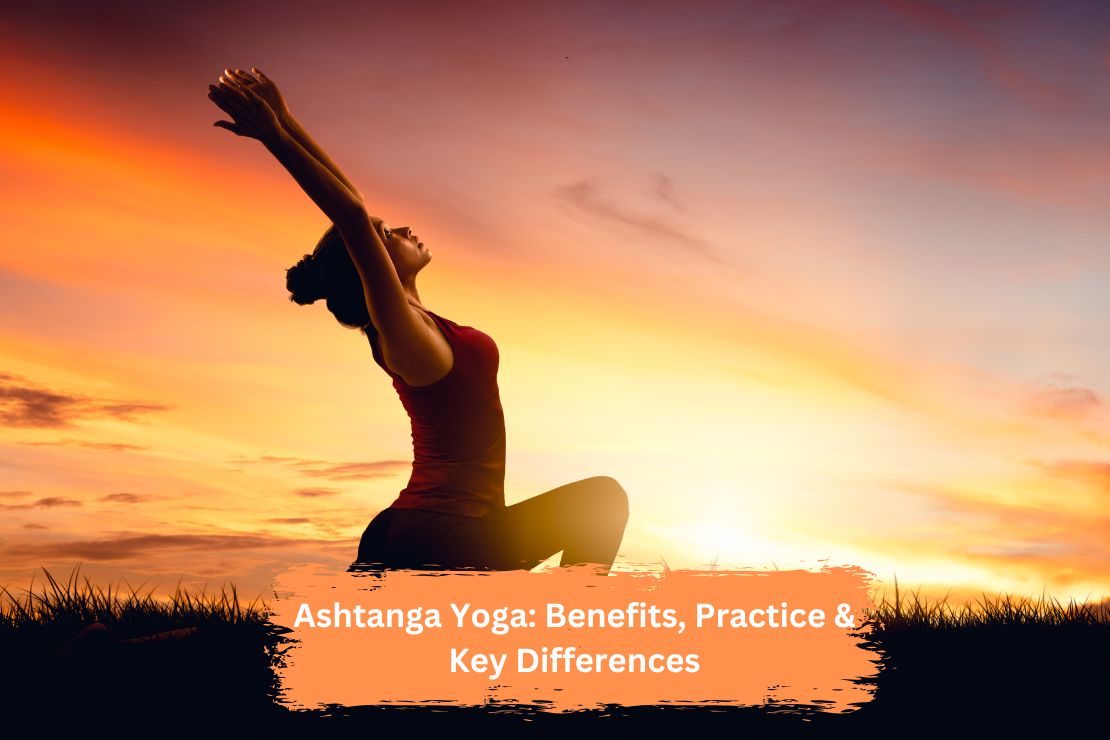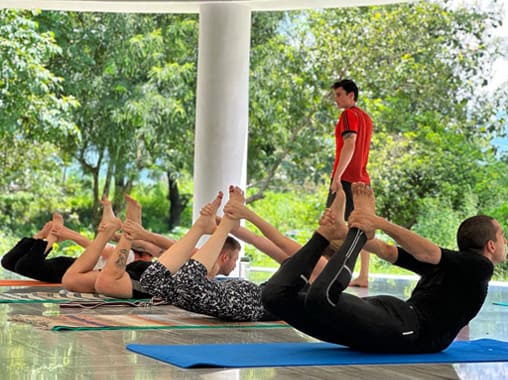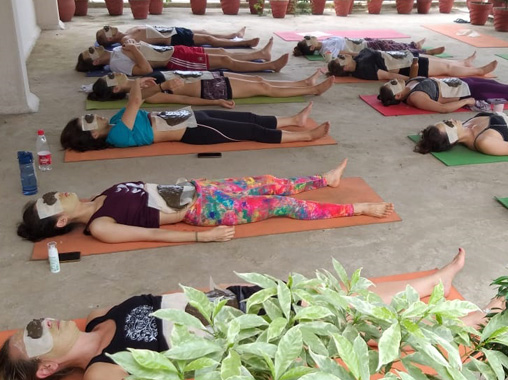
Yoga has been the cornerstone of spiritual and physical welfare for centuries. Though many styles are practiced today, Ashtanga has held its dominance and stands out for its structured approach, discipline, and transformative potential.
It synchronizes the breath with dynamic and physically demanding practice movements and provides many mental and physical benefits.
It doesn’t matter whether you are a beginner or an experienced practitioner. Understanding Ashtanga Yoga can help you integrate it into your routine for your holistic well-being.

What is Ashtanga Yoga?
The word Ashtanga is a combination of two. Where Ashta refers to the number eight, and Anga is an acronym for limbs or body parts. Ashtanga is the integration of eight branches of yoga philosophy into a single comprehensive system. These eight limbs of yoga include
1. Yama:
This philosophy of yoga is dedicated to the moral guidelines that are essential for a good life. These principles include Satya (truth), Ahimsa (non-violence), and Asteya (non-stealing).2. Niyama:
The second limb out of the eight limbs in Ashtanga yoga. This teaches you self-discipline, which is a must for a good life. There are five Niyamas:- Shaucha: Purity, clarity of mind, speech, and body
- Santosha: Contentment, acceptance of others, and acceptance of circumstances
- Tapas: Persistence, perseverance, austerity, asceticism, and self-discipline
- Svadhyaya: Study of the Vedas, study of self, self-reflection, and introspection
- Ishvarapranidhana: Contemplation of God or the cosmic presence
3. Asana:
It is the practice of physical posture in Ashtange yoga. These poses improve your body and muscle strength, enhance flexibility, and allow you to be more balanced. With the help of these asanas, you can prepare yourself for the deeper spiritual practices and meditation.4. Pranayama:
Pranayama is the art of breath control in Ashtanga yoga. This next limb of Ashtanga yoga teaches you how to regulate and control your breath pattern. By doing Pranayama regularly, you will be able to foster a deeper connection between mind, body, and spirit.5. Pratyahara:
The Fifth limb of Ashtanga yoga, where you will learn how to detach oneself from the senses and concentrate on increasing the attention rate inward. This limb is required for mental calmness and inner exploration.6. Dharana:
Under this limb of Ashtanga, you will learn how to improve your focusing power. This practice improves mental clarity and concentration. The continuous practice of this limb is important for advancing meditation to a deeper state.7. Dhyana:
This seventh limb in Ashtanga yoga involves a meditation practice that teaches you effortless concentration. This meditation practice fosters effortless concentration where your negative thoughts will diminish and allow you to have profound inner peace.8. Samadhi:
Last stage of Ashtanga Yoga, where you are in a state of meditative consciousness or enlightenment. In this last stage of Ashtanga yoga, the practitioners experience unity with the cosmos and are successful in surpassing their ego.Difference Between Vinyasa and Ashtanga Yoga
Ashtanga and Vinayasa are different yoga styles that are performed to establish sync with breathing and flowing movements. However, these two yoga asanas are different in many aspects. A list of a few is detailed below.In the Structure Aspect
Ashtanga yoga follows an exact sequence of poses in a disciplined and traditional way. Whereas Vinyasa yoga allows flexibility in its sequence, which can vary from class to class.Pace
Ashtanga yoga is generally practiced more quickly than Vinyasa yoga. Each posture in Ashtanga yoga is held for five breaths, and students get minimal rest in performing the poses. On the contrary, vinyasa involves flowing movements. Its pace can vary based on the teachers and classes. As compared to the Ashtanga, Vinyasa is more adaptable to different fitness levels and preferences.Focus
Ashtanga yoga strictly emphasizes discipline, tradition, and sequential steps of yoga postures, which demands a high level of concentration. Vinyasa, on the other hand, appeals to people who appreciate variety and artistic expression because it emphasizes fluidity, creativity, and the smooth integration of breath and movement.Breath
Both yoga poses are based on establishing equilibrium between breath and movements, but Ashatanga follows a specific breath pattern that is taught and brought into practice throughout the session of Ujjayi Pranayama. While Vinyasa yoga does not follow any specific breathing techniques. It is important to know that you need to prioritize your personal goals when it comes to choosing between Ashtanga yoga and Vinyasa yoga. Ashtanga Yoga is for those individuals who want to proceed with consistency, structure, and traditional methods. On the flip side, Vinyasa yoga is suitable for those who prefer creativity, variety, and adaptability over rigidity.
Ashtanga Vinyasa Primary Series: A Closer Look
The foundation of Ashtanga Yoga is the Ashtanga Vinyasa Yoga Primary Series, also known as Yoga Chikitsa (Yoga Therapy). This series, also known as the Ashtanga Primary Series, is made of sequential poses that are ultimately meant to increase flexibility and strength and detoxify the body. This series, also known as the Ashtanga Primary Series, is made up of a predetermined order of poses meant to increase flexibility and strength and detoxify the body.Key Poses in the Ashtanga Primary Series
- Sun Salute (Surya Namaskar A and B): Warm-up and activation.
- Permanent attitudes: Create strength, balance, and flexibility.
- Posing and sitting: improves flexibility and stimulates digestion.
- Backbands: Open the heart and strengthen the spine.
- Finishing sequence: Includes inverse and relaxation to seal the practice.
Benefits of Ashtanga Vinyasa Yoga
The practice of Ashtanga yoga regularly provides many benefits:- Increases power and flexibility, deepening the muscles for better mobility and endurance.
- It increases asana and balance, strengthens the spine, and stabilizes the body.
- The heart increases health dynamic flow, increases heartbeat, and improves circulation.
- Reduces stress and anxiety, and deep breathing soothes the nervous system.
- Improves focus and concentration, structured sequence cultivates discipline and mental clarity.
- Mind-body increases attachment of mindfulness and self-awareness.
Conclusion
Ashtanga yoga is a powerful and structured practice that provides great physical, mental, and spiritual benefits. It is a path of self-discovery, self-control, and transformation. Although this may seem challenging initially, frequent practice has better health, a cool mind, and a strong relationship with you. Whether you are a beginner or an advanced yogi, including Ashtanga yoga in your routine can lead to general welfare.FAQs
1. I am a beginner. Can I practice Ashtanga Yoga?
Yes, you can, but as a beginner, you need to practice Ashtanga yoga under the guidance of an experienced instructor to learn proper adjustments and modifications.
2. How many times should I practice Ashtanga Yoga?
Ideally six days a week, with a comfort day. However, you can start 2-3 times during the first week and grow gradually.
3. Do I need to practice Ashtanga Yoga for weight loss?
Yes, you can. The powerful nature of Ashtanga Yoga burns calories and produces lean muscles while helping weight loss.
4. Is Ashtanga yoga good for the heart?
Yes, Ashtanga yoga improves your heartbeat and makes your heart more healthy.
5. How does the breath in Ashtanga yoga work?
Ujjay helps regulate breathing.
6. How is Ashtanga Vinyasa Yoga helpful for me?
It assists you in detoxification and mental clarity and improves discipline, focus, and cardiovascular health.





